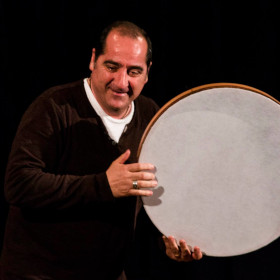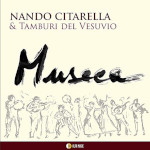

Nando Citarella & Tamburi del Vesuvio "Museca",
Alfa Music, 2020
@ FROG
www.nandocitarella.it


Actor and opera singer, Nando Citarella (born Donato) developed the basis of his career by studying with Eduardo De Filippo, Dario Fo, Ugo Gregoretti and Roberto De Simone, thanks to whom he could perform in his first theatrical performances. The passion for the popular traditions of the South led him to be included, in 2003, in the Register of Italian and European writers and artists of the Italian National Commission for UNESCO, as an honorary member. Nando is also one of the band members in Bella Ciao, whose latest CD is also reviewed in this issue of FolkWorld.
In 1994 he founded the Tamburi del Vesuvio, a Neapolitan popular music group. In this album, ‘Museca’, Citarella presents a repertoire of 13 songs inspired in the Italian traditional folk, but also fused with influences from several other music cultures. For instance, the profuse performance of North African style percussion is noticeable throughout the entire album.
Also the first song, ‘Rumba Scugnizza’ (music D.Citarella, lyrics R.Vivani), is precisely that, a Cuban rumba performed by: Valter Paiola (vocals, guiro, tumba, maracas, clave, trombone), Luigi Staiano (vocals), N.Citarella (vocals, tamburello), Salvatore Rotunno (guitar), Giovanni Lo Cascio (darbuka, davul), Alessandro Pati (electric bass guitar), Alberto D’Alfonso (flute, sax), Vanessa Cremaschi (violin), Nello Salza (tromba).
Although the musical background of all the artists on the CD is rooted in Italian traditions, including their singing style or use of the tamborello, Nando Citarella's band has made a recognizable effort to blend them with other Mediterranean influences, including the ‘Latin’ ones from across the Atlantic ocean, Cuba, Brazil,...
You listen to 'Kopanitz Molisana' and find odd time signatures from the Balkans, Macedonia, Montenegro or Albania. ‘Makam por una Estrella’, with lyrics in Spanish, and Steffano Saletti (oud) and Pejman Tadayon (nei, duf), takes you back to the days of the coexistence of the Christian, Arab & Jewish cultures in Andalusian cities such as Granada, Cordoba or Seville.
But in ‘Suite Ciro’ you find the fusion between an Italian ‘canzone di spartenza’, ‘Strada Passagera’ (about the migration to America) and the Cuban Carlos Puebla’s ‘Hasta Siempre Comandante’ (Che Guevara). In the medley 'Suite Os Tambores' (Milton Nascimento’s ‘Os Tambores de Minas Gerais’ & D.Citarella’s ‘A Fronna ‘E Tambor’), the crossing occurs with Afro-Brazilian percussion, performed by Giovanni Volpe (Caixa, repinique, surdo, shekere', timba) and Antonio Montuouri (pandeiro, contra surdo, campagna, agogó', chocalho).
Even the final theme, 'A Vita è Musica' (D.Citarella), where all the musicians in the recording perform to the rhythm of a rumba, like at the beginning of the album. But there's also, for example, 'Suite Ballerina', basically three tarantella dance songs in the classic way, with the beautiful & powerful voice of Gabriella Aiello and the tamburello of Pina Valentino.
'Museca' is a truly captivating sampler that shows how music knows no borders, how traditional styles from Italy, or from other places along the Mediterranean Sea or the American continent can fraternally merge under common folk origins.
Photo Credits:
(1)-(2) Nando Citarella,
(3) A Sud Di Bella Ciao
(unknown/website).